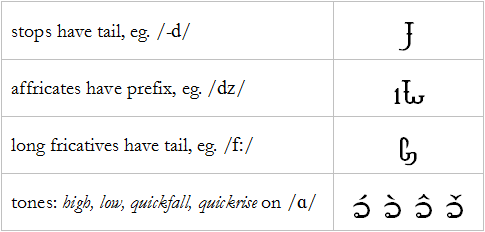This is a script modeled roughly on the component-based scripts of SIGIL (see main Orthographies page). It follows after Amethyst in a series of easy-to-write alphabets founded on phonetic principles.
Main consonant series
In this script, the glyphs are modeled so that the phonetic region of the lips (P) is imagined at the right, whilst the back of the mouth (H) is imagined at the left. As with early versions of SIGIL, the bottom half of each glyph shows how the phoneme will be articulated. Voicing is indicated with a small crossbar on the vertical stem. (Phonemes in red are not represented in the current font, but their glyphs can easily be deduced.)
Vowels
In the main vowel series, the relevant point of formation in the mouth is indicated with a small circle. Its relative position within the glyph-space roughly reflects its placement in IPA charts. For the centralized vowels, the relevant point is shifted back around the bowl-shape and marked with a notch. The bowls are drawn anti-clockwise.
Other glyphs and modifiers
The /s/ and /z/ glyphs are adapted from the /t/ fricatives. Plain unvoiced lateral fricative is derived from the vowel /l/.
Sample text
This is the beginning of Shakespeare’s sonnet 18 again (transliteration), for comparison with versions of SIGIL etc.
“Shall I compare thee to a summer’s day?
Thou art more lovely and more temperate;
Rough winds do shake the darling buds of May,
And summer’s lease hath all too short a date.”







